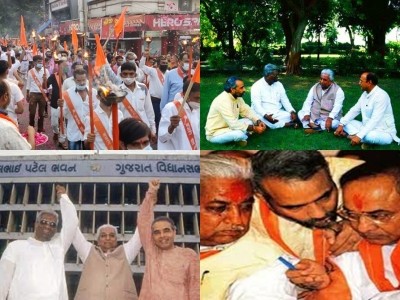
Gandhinagar, Till 1985 the BJP was sitting on the edges of the state electoral game. Hardly 9 or 11 MLAs used to get elected to the state assembly of 182 seats, they had a negligible presence in the civic and panchayat polls. Then came the Ram Shil Pujan Yatra in 1987-88, followed by an anti- Congress wave over corruption allegations in the Bofors guns procurement in 1989. The turning point was the Somnath to Ayodhya Ram Rath Yatra of BJP leader L K Advani which laid a very strong foundation for the party in Gujarat.
Resultantly in 1995 for the first time the BJP formed the government in the state by itself. The Election Commission of India's data shows that even though the Congress was at its peak, there were average 37% anti-Congress votes. That used to be divided between the Jan Sangh/BJP and the Janata Party or Janata Dal.
The other major development that took place in the 1990s was the sudden demise of Chief Minister Chimanbhai Patel while Congress stalwarts like Madhavsinh Solanki and Jeenabhai Darji announced their retirement from active politics. Leaders like Sanat Mehta, Prabodh Raval and other senior leaders were losing ground. The merger of the Janata Dal (Gujarat) with the Congress proved to be a big boost for the BJP because the anti-Congress votes that the Janata Dal/Janata Party was harvesting shifted to the BJP.
The election commission's data clears the picture. In the 1980 elections the Janata Party (JP) and the Janata Party (Secular) polled 23 per cent votes, the BJP 14 per cent. In the 1990 elections, the BJP polled 26.69 per cent and the Janata Dal got 29.36 per cent votes. In the 1995 elections the BJP polled 42.51 per cent votes. The Janata Dal in the absence of Chimanbhai Patel could attract only 2.82 per cent votes.
Three to four major developments in the late eighties and early nineties helped the BJP to grow faster and spread its influence. Firstly the Ramjanmabhoomi movement, secondly, the BJP that was considered a party of Brahmins, Banias, Patels and other upper castes started attracting people from the OBC and other backward classes. The strengthening of the party cadre and an inclusive approach has majorly boosted the party strength in less than one decade, says Dr Anil Patel, senior BJP leader.
The party focused on 146 sub-castes falling under the OBC category and also focused on professionals like barbers, auto-rickshaw drivers, and such organizations, which introduced them to mainstream politics through the BJP. Along with social engineering, the party worked on social decentralisation and empowerment that has deepened the party roots in the state, explained Patel.
If the Godhra incident has consolidated Hindu votes more strongly, the incident also helped in eradicating appeasement politics -- factors which have helped the party to remain in power for long and will make it keep winning continuously, he opined.
The BJP led the state from instability to stability and Narendra Modi provided the much needed leadership with vision, which is the crux of the party having a strong hold in the state and retaining power for more than 20 years, said Sudhir Raval, political analyst.
According to Raval, during the Congress regime there was instability like frequent changes of chief ministers, President's rule, riots, because of which the development of the state was being hampered. Against that, Modi provided strong leadership for 13 years, his vision of development has put the state on the global map, and his consistency in delivering on promises is what keeps the BJP afloat even in troubled times.


.jpeg)

